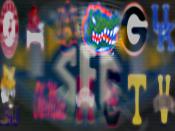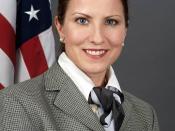Accounting regulations are a very fundamental requirement within industries of today. Over the past few decades, many issues arose due to the lack of accountability and trustworthiness among large businesses, and these issues led to large scale effects on the business world as a whole; domestically well as internationally even in some instances.
In the following paper, regulatory bodies such as: GAAP, IFRS, SEC, and PCAOB will be discussed in connection with two major companies within the oil industry: Transocean and Chevron. Accounting reporting criteria and how it differs between these two major companies will also be discussed.
When looking at domestic and global companies using Chevron and Transocean as examples, the regulatory environments have many similarities. As publicly traded American companies, these two businesses are required to adhere to standards and regulations established by United States regulatory bodies such as Financial Accounting Standards Board (FASB), which establishes Generally Accepted Accounting Principles (GAAP) standards in the US.
Due to international operations, standards established by the International Accounting Standards Board (IASB) must be followed. The main purpose of the IASB is to "develop, in the public interest, a single set of high quality, understandable and international financial reporting standards (IFRSs) for general purpose financial statements" (IASB 2009). As a result of the multitude of accounting policies and regulators that these companies must be accountable for, financial recording practices need to be more complex than domestic only companies.
GAAPGAAP standards vary from country to country. To begin, US GAAP is very similar to IFRS. In 2008, the U.S. Securities and Exchange Commission (SEC) proposed that IFRS replace U.S. GAAP for U.S. public companies in 2010 to be completed by 2014 (Epstein, 2008). Surprisingly, accounting standards in compliance with IFRS are less detailed than those of the U.S. GAAP. However, convergence is important for those who participate in the global market.
IFRSDespite the possibility of accepting the IFRS, U.S. companies are still required to follow the U.S. GAAP. The following are some examples of differences between the two standards. The 2008 website shows that the pooling of interests method is exceptionally used only when strict criteria are met with the IFRS versus the U.S. GAAP purchase method only. Goodwill is strictly amortized with impairment with IFRS and is not amortized with the U.S. Assets are measured by the recoverable amount in IFRS versus the fair value in the U.S. Retirement benefits are handled differently in that gains or losses are strictly amortized in IFRS without corridor while they are corridor amortized in the U.S. The scope of subsidiaries in consolidated financial statements is based on control in IFRS and is based on majority voting interest in the U.S. The U.S. and IFRS also have many similarities in the measurement of securities, estimating potential credit losses/impairment, recognition of financial assets, measurement of dividends, hedge accounting, basis methods of business combinations, grouping of assets, and income taxes to name a few. The U.S. Securities and Exchange Commission, also known as the SEC, is one of the main regulatory bodies in the United States that govern the accounting practices of publicly traded companies. "The mission of the U.S. Securities and Exchange Commission is to protect investors, maintain fair, orderly, and efficient markets, and facilitate capital formation" (U.S. Securities and Exchange Commission, 2009, Investors Advocate ö 1).
To aid in achieving this mission, the SEC has established a number of laws and regulations to monitor the accounting practices of corporations and to ensure that investors have access to a company's complete and accurate financial records (U.S. Securities and Exchange Commission, 2009).
One of the major recent achievements of the SEC was the establishment of the Sarbanes-Oxely (SOX) Act of 2002, signed by President Bush (U.S. Securities and Exchange Commission, 2009). The purpose of the SOX was to hold corporations to a higher standard of accountability when it comes to their financial records, and to increase investor confidence.
PCAOBAnother regulatory board that oversees the accounting practices of publicly traded companies is the Public Company Accounting Oversight Board (PCAOB). The PCAOB is a nonprofit company created as a result of the Sarbanes-Oxley Act of 2002 (Public Company Accounting Oversight Board, 2009). The main purpose of the PCAOB is to ensure that the audit reports of corporations are accurate, reliable, and fair. This goal is achieved through a set of auditing standards implemented by the PCAOB, including evaluating the consistency of a company's financial statements and monitoring internal control over financial reporting (Public Company Accounting Oversight Board, 2009).
Transocean Inc. and Chevron are two publicly traded companies that must adhere to the standards set forth by the SEC and the PCAOB. The information presented in the 10-K reports of each of these corporations complies with the established accounting standards by disclosing all pertinent financial information to investors. In addition to disclosing financial information to investors, Transocean and Chevron have also made their financial records available to regulatory bodies such as the SEC, PCAOB, and others to examine and evaluate.
Accounting Reporting Criteria in Transocean vs. ChevronRegulatory EnvironmentSome countries may have similar accounting regulatory systems, but according to Edmonds, McNair, Old and Schneider, no two countries have exactly the same accounting regulatory systems. The International Accounting Standards Board (IASB) is an independent and privately held that develops and approves International Financial Reporting Standards. The IASB adopted the International Financial Reporting Standards commonly referred to as IFRS.
As it relates to environmental issues with foreign currency, Chevron Corporation's environmental regulation is determined by the existing laws in each of the countries in which the Group operates and within their own internal standards. The Group capitalizes expenditures that create future benefits or contribute to future revenue generation. Remediation costs are accrued based on estimates of known environmental exposure even if uncertainties exist about the ultimate cost of the remediation. Such accruals are based on the best available non-discounted estimated costs using data developed by third party experts. With the introduction of the Sarbanes-Oxley Act of 2002 (SOX), the accounting practices of foreign companies have merged with the practices of the United States accounting practices.
Foreign currency conversion is an essential concept to U.S. and foreign accounting. Majority of Transocean's revenues and expenditures are predominately in U.S. dollars. The reason for this is to limit Transocean's exposure to foreign currency fluctuations. Transocean's revenue had net losses of $3 million, $10 million and $3 million for the years 2008, 2007 and 2006, respectively (Transocean 10-K, 2009).
In order for Transocean, Inc. to report appropriately on global business activity in September 2006, the Financial Accounting Standards Board ("FASB") issued SFAS No. 157, Fair Value Measurements ("SFAS 157"). This defines fair value, establishes a framework for measuring fair value in generally accepted accounting principles, and expands disclosures about fair value measurements.
Differences in GAAPWhen reviewing both Chevron and Transocean's methods of account recording, clear contrast is apparent. Although the FASB strongly urges such large publicly owned corporate companies like Chevron and Transocean to comply with their Generally Accepted Accounting Procedures (GAAP), accounting methods will remain pertinent to the most beneficial methods of business for each company.
Chevron abides to the best of its ability by the FASB's GAAP standards to ensure clear communication of its financial accountability. According to Note 1 of the Summary of Significant Accounting Policies,The company's Consolidated Financial Statements are prepared in accordance with accounting principles generally accepted in the United States of America. These require the use of estimates and assumptions that affect the assets, liabilities, revenues and expenses reported in the financial statements, as well as amounts included in the notes thereto, including discussion and disclosure of contingent liabilities. (Chevron Annual Report 2008)In contrast, Transocean practices unconventional methods of financial recording that would be considered "Non-GAAP" accounting procedures. To reconcile these methods, Transocean offers similar notable reports such as "Adjusted Net Earnings and Diluted Earnings Per Share" statements, "Total Debt to Net Debt and Total Capital to Tangible Capital Reconciliations" statements, and "Operating Income Before General and Administrative Expense to Field Operating Income" statements. Although GAAP procedures would be more plausible for U.S. standards, Transocean chooses alternative methods to accommodate its international business since it incorporated in the Cayman Islands. The standard reporting requirements in the Cayman Islands also likely vary from the standards within the USA.
As long as companies choose to operate in a global environment, there will be issues with the accounting reporting criteria based on the country of origin and the country of operations. The differences between Generally Accepted Accounting Principles will continue to plague financial report preparers though some resolution may be in sight. As the United States GAAP merges with the IASB standards, the flow of financial information that does not need adjustment across national boundaries will be expedited. The accounting reports submitted by Chevron and Transocean will continue to be influenced by the FASB and IASB convergence project in an attempt to make the standards more similar. Some of the standards however, will remain separate and unique due to the factors involving operations and financial aspects of global markets. Making financial records available to regulatory bodies such as the SEC, PCAOB, and others to examine and evaluate will also continue to be necessary for Transocean and Chevron in an effort to comply with requirements in operations.
As discovered in this research, Transocean and Chevron employ different forms of financial recording and reporting. While the result is the same concerning accountability requirements, Transocean was discovered to use some unconventional methods of recording, although it was required to still maintain the same levels of accountability through reporting the results in order to accommodate international business records. An important note to remember is also that Transocean is not a USA company. While it operates within the USA, Transocean is incorporated in the Cayman Islands. This fact also influences recording and reporting criteria that is required and followed with the US division of Transocean.
ReferencesChevron Corporation (2009). Chevron Annual Report, 2008. Retrieved July 7, 2009 fromhttp://www.chevron.com/annualreport/2008/financials/notestothefinancialstatements/note1.aspxEdmonds, Edmonds, McNair, Olds and Schnieder. Fundamentals Financial Accounting Concepts. Retrieved through University of Phoenix eResources, retrieved on July 25, 2009.
Epstein, Barry J. (2008). IFRS versus GAAP. Russell Novak & Co., LLP. Retrieved July 25,2009, from http://www.ifrsaccounting.com/IASB (2009). IASB-About us. Retrieved July 25, 2009 from http://www.iasb.org/About+Us/International+Accounting+Standards+Board+-+About+Us.htmPublic Company Accounting Oversight Board (2009). Retrieved July 23, 2009 from www.pcaobus.orgTransocean, Inc. (2009). Retrieved July 25, 2008 fromhttp://deepwater.com/fw/main/Non-GAAP-Financial-Measures-132.htmlTransocean, Inc. (2009). Retrieved July 25, 2008 from http://www.deepwater.com/fw/main/default.asp?DocID=57&FilingType=10-K&Page=1U.S. Securities and Exchange Commission (2009). Retrieved July 22, 2009 from www.sec.gov





